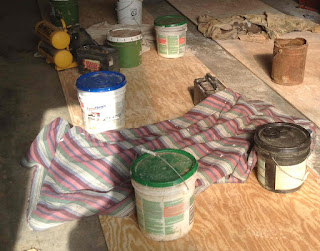 |
| Go Samson! Who said hippies aren't tough??? |
As long as I am doing bulkheads, I figured I might as well do the bow and stern transoms. At the corner of each, I wanted to do Samson posts. I expect they will be handy and look shippy.
I cut some pieces off a black walnut 6X6 that has been sitting on an old disker (farm machinery) in Dad's field for several years.
They look really rough, but cut off that outside 1/2" and it is as purty as the day it was sawed.
Wasn't sure about the design, so I made a practice piece with white pine...
And tested it.
Then I shaped the posts and sanded them down with some handy-dandy long strips of sandpaper a friend gave me. Note the back-lit flying sanding dust.
Here is the port side one attached to the 1 3/4" pine board I'm using for the bow transom.
The greenish wood on top of the transom is s strip of black locust I put on to protect the edge of that pine board. Locust will take a beatin'.
 |
| Hmmm... This picture looks strangely familiar when you crop it like this. |
I wish I had a bronze rod to use as a pin. I hear old keel bolts proliferate in boatyards, but we don't have boatyards in the mountains. I'm using copper pipe with plugs in the end that my friend, Jeff, made me out of black locust on the lathe. There will be 1/2" steel rod epoxied inside for strength. Just potting it up with resin would probably give all the strength they need. I'm not sure these need to be strong at all and, being on the corner like this, I may well wish that little protrusion had been hollow when I run it into a piling and it rips the whole aft face off of the post. Not to worry. If that happens, I'll just cut it off with a chainsaw and screw in a cleat like regular people use.
 |
| Camila hiding between the boat side and the wall. (It's well supported, don't worry) |
















































